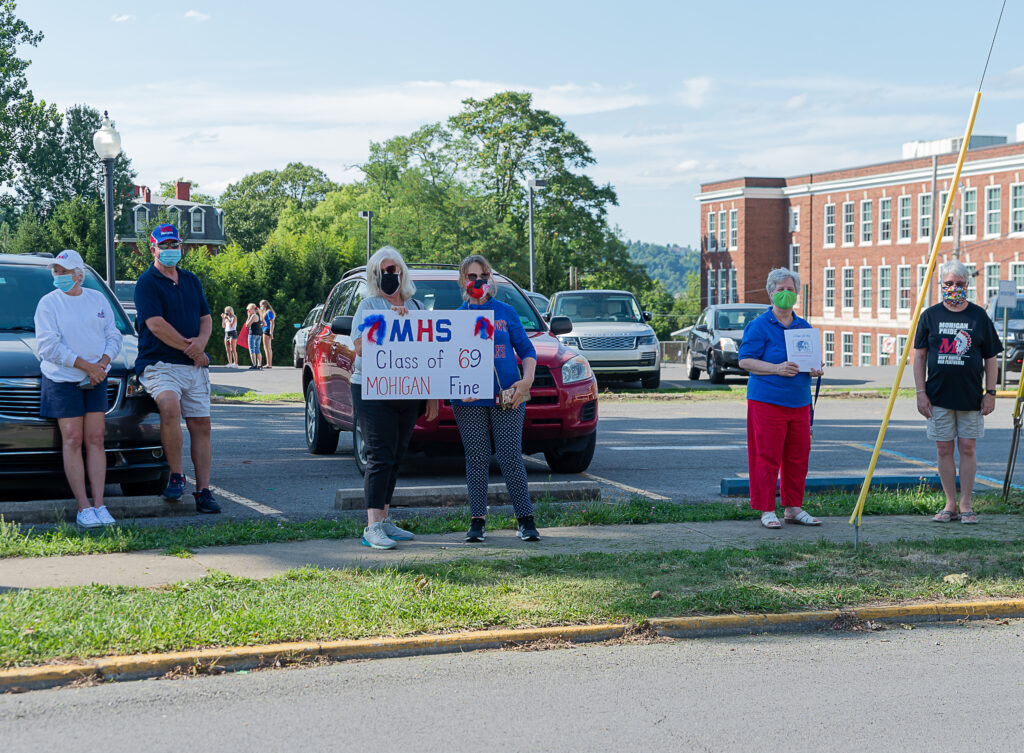Those in favor of the high school mascot gathered Wednesday
Do you remember the particulars of the 1966 Orange Bowl matchup between Alabama and Nebraska?
Neither do Karen Paulin and Toni De Biase.
But then again, the game in Miami more than 50 years ago wasn’t the objective.
Hitting their marks during the halftime show was the only mission for the members of Morgantown High School’s Red and Blue Marching Band.
“That was the exciting part,” Paulin said.
“And our band went everywhere,” seconded De Biase, her roommate on that trip.
Which meant that the image of the MHS Mohigan went everywhere, too.
Paulin and De Biase, both Class of 1969, were among the 30 or so people gathered in the parking lot of the school on Wilson Avenue for a rally — the second in as many weeks — to save the school’s signature Mohigan, which isn’t so much a mascot as it is a historical narrative of the school.
In recent days, that historical narrative has turned into public discourse, and public protest, as a student-led group fronted a petition to rid the school of such imagery, which it says is insulting to Native American culture.
Such imagery is especially in the marching band. The drum major traditionally wears a full, feathered headdress.
The majorettes that follow — known as “Mohiganettes” — are adorned in fringes and feathered head bands.
Students came up with the idea for the-then new school (built in 1927) when they appropriated “Mohigan” by a mashed-up abbreviate of the yearbook: The Morgantown High Annual.
“Mohigan” sounded like “Mohican,” the Native tribe, so it was easy to co-opt the imagery in a region steeped in indigenous culture.
The river that bisects Morgantown and Westover, for instance, derives its Monongahela name from a Native word meaning, “falling banks.”

D.C. victory
Which, is the problem, opponents of the Mohigan say.
Proud cultural traditions were lifted, they say, then used out of context, before ultimately becoming caricatured.
And the debate goes well past the confines the local waterway with edges that don’t always hold.
The now-former Washington Redskins of the NFL now carries the placeholder name, “The Washington Football Team,” while management, advocates and fans work for something more inclusive.
That was a victory in a cultural war that lasted 52 years, technically.
The National Congress for American Indians began lobbying in earnest in 1968 for the removal of such imagery in sports for all the above.
‘Always Mohigans’
Meanwhile, the Monongalia County Board of Education says it will listen to both sides of the debate as the school and the district works to consider dropping the Native American trappings from the school.
Or, not dropping them.
Mike Rockis is hoping for the latter, and his feelings are also related to all of the above reasons.
Most notably, the pervasive Native culture which he respects, and which his late father, John, drew upon during his time roaming the sidelines at MHS.
The elder Rockis got into education and coaching after he came home from the fighting in World War II.
“The Mohigan and all its symbols has been used to build leaders,” Rockis, the younger, said.
“There are some pretty distinguished graduates of this school. Young people need this tradition.”
Andy and Judy Morris were husband and wife high school sweethearts who graduated from MHS in 1965 and 1967, respectively.
Like Coach Rockis, both said they remain proud of what the school was then, and what it is now.
“Always Mohigans,” Andy Morris said.
TWEET @DominionPostWV





